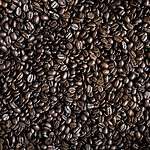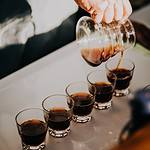Affiliate disclosure: We are reader-supported. This means that we may earn a commission if you buy an item using one of the links. For our reviews, we purchase products ourselves and review them independently. Read more about our methodology.
Summary of Key Differences
Below we summarize the key differences between a French Press and a Chemex. The key differences between a French press and a Chemex is how they brew coffee, how easy they are to use and what taste they produce.
We generally prefer using a Chemex over our French press because we love the ease of cleaning it and the super smooth taste it produces.
| French Press | Chemex | |
|---|---|---|
| Prices | $20 - $120, with some high-end models above $200 | $38 - $161 |
| Brewing method | Press | Pour-over |
| Supplies needed | None | Paper filters |
| Grind size | Coarse | Medium coarse |
| Sizes offered | Single to multi-cup | Single to multi-cup |
| Other uses | Tea brewer; manual milk frother | None recommended |
| Storing and reheating coffee |
|
|
| Cleaning | It depends on the make and model, most French presses are handwash only | Dishwasher safe or handwash |
| Materials | French presses can be made from glass, stainless steel, ceramic, stoneware, or other materials. Many French presses have plastic handles, caps, or feet | Chemexes are made from borosilicate glass; some styles have a removable wooden and leather handle |
| Great for |
|
|
Brewing Differences
A French press and Chemex are methods for brewing coffee; however, there are some key differences between the two.
As its name implies, a French press is a press method of brewing coffee. When you use a French press, you add coffee grounds and hot water into the chamber, letting the coffee grounds brew in the hot water for several minutes. When it’s done brewing, you press the coffee grounds down with a plunger to extract additional oils and flavonoids from the coffee and to make sure you don’t get any grounds into the coffee you drink.
A Chemex is a pour-over method for brewing coffee. The Chemex is a glass carafe that is shaped like an hourglass, with a wide opening at the top to fit a filter. When you brew coffee with a Chemex, you place a filter in the opening and add your coffee grounds. You add a bit of hot water to allow the coffee grounds to bloom, which allows gasses to escape and improves the flavor of the coffee.
After it blooms, you add more hot water, which will drip through the filter into the bottom of the Chemex. You remove the filter and coffee grounds to pour the coffee out.
Grind Size
There are several other key differences between a Chemex and a French press. A French press uses a coarse grind and a Chemex uses a medium coarse grind.
While you can use a finer grind in a French press, it will be harder to press and may result in a more bitter brew. Using a coarser grind in a Chemex will result in a more acidic brew.
Storing and Reheating Coffee
After brewing, there are differences in how to store your coffee, especially if you’re like us and make extra coffee and let it sit out for a while. In a French press, because the coffee grounds remain mixed with hot water, it is recommended to decant your coffee by pouring it into another container. If you let it sit in the French press, it will continue to brew and get more bitter.
You won’t need to decant coffee from a Chemex because the water will pass through the filter while the coffee grounds remain in the filter. You can also place a Chemex directly on a glass or gas flame stovetop on low heat to keep your coffee warm (you cannot place a Chemex on an electric coil stovetop). It’s not recommended to place a French press directly on a stovetop as it may break or warp.
Other Uses
A French press has other uses besides brewing coffee. You can use it to make certain loose-leaf teas, following the same method to brew coffee.
You can make tea in a Chemex, but because the water will pass through the tea leaves, it results in a much weaker tea. You need to use more tea leaves in a Chemex to produce the same strength you’d get from steeping fewer leaves in hot water.
For that reason, we recommend the French press over a Chemex if you want to make tea. A French press can also be used as a manual milk frother.
- Iconic French press coffee maker that brings out the full flavor and aroma of your brew
- Large 1-liter capacity, enough for 8 cups*
- The carafe is made of non-stain, heat-resistant borosilicate glass that won’t alter or impair the coffee’s natural flavor
- Note: 1)Too coarse a grind, too little coffee, or insufficiently tamping the grounds before brewing can all lead to inadequate pressure for a proper brew. 2)It...
- Add Coarsely Grounded Coffee. Add Hot Water. Wait 4 Minutes. Plunge.
- Environmentally friendly: No paper filters or plastic capsules required.
Cleaning
The Chemex is easier to clean than a French press. The Chemex is one piece of glass and it is dishwasher safe. Because Chemex uses a paper filter, it prevents the coffee grounds from getting into the carafe. For cleaning purposes, this means that swirling hot soapy water in the Chemex is enough to clean it.
French presses have multiple parts, and because you put coffee grounds directly into the press, this means more cleaning. What’s more, most makes and models of French presses are not dishwasher safe.
Price
A six-cup classic Chemex, which has a capacity of 30 oz, is $49.50. There are other brands that make Chemex-style pour-over carafes, with prices ranging from $20 to $80. Meanwhile, a similar-sized, mid-tier French press is around $20-$30.
There are high-end options for both types. A hand-blown five-cup Chemex will run you about $125. High-end French presses of a similar size sell between $80 and $120, with some very expensive models above $200.
High-end French presses are generally made from stainless steel, ceramic, or stoneware. All Chemexes are made from borosilicate glass, while other brands may be made from glass or other materials.
Which One Do We Prefer?
We like both the French press and Chemex because they are easy methods for making multiple cups of coffee, which is a must in any house with more than one coffee drinker.
We generally use our Chemex more than our French press because we like the taste produced by a pour-over brewing method. We also like the ease of cleaning. We especially love that we can leave coffee in the Chemex without taking the coffee out to sit or reheat. The main downside, in our opinion, is the need to use paper filters due to waste. However, there are many brands of coffee filters that are biodegradable and compostable.
- CHEMEX - simple, easy to use with timeless, elegant design
- All CHEMEX Coffeemakers are made of the highest quality, non-porous Borosilicate glass which will not absorb odors or chemical residues
- The patented CHEMEX pour-over design allows coffee to be covered and refrigerated for reheating without losing flavor
- CHEMEX - simple, easy to use with timeless, elegant design
- All CHEMEX Coffeemakers are made of the highest quality, non-porous Borosilicate glass which will not absorb odors or chemical residues
- The patented CHEMEX pour-over design allows coffee to be covered and refrigerated for reheating without losing flavor
We believe a French press requires less “art” to it, making it more accessible for the newbie at-home brewer. Pour-over coffee makers like the Chemex require letting the coffee bloom. There are also specific ways to pour water over the grounds to produce the best brew. It also helps to have a gooseneck kettle to achieve a better pour.
A French press is less discerning in this regard. You can let the coffee grounds bloom in a French press by adding a little hot water before pouring in the rest, but you can still get a good brew without doing this. Since the water will submerge the coffee grounds in a French press, there’s not much art to how you pour the water.






